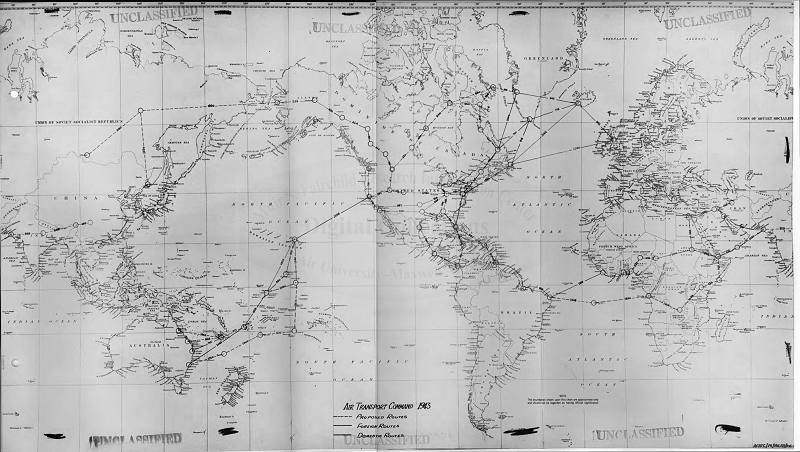
A.W.P.D.-42Air Transport Requirements |
AIR TRANSPORT COMMAND REQUIREMENTS
1943
AIRCRAFT
|
Transport Aircraft |
Required |
Allocated |
To Be Allocated |
|
Two Engine |
806 |
520 |
286 |
|
Four Engine |
1199 |
280 |
919 |
PERSONNEL
|
Flight Personnel |
Total Required |
On Hand or Allocated |
Air Corps Training |
Airlines Training |
Total to be Trained |
|
Pilots |
8,851 |
3,421 |
2,715 |
2,715 |
5,430 |
|
Co-Pilots |
6,736 |
2,239 |
2,248 |
2,249 |
4,497 |
|
Navigators |
3,931 |
542 |
1,694 |
1,695 |
3,389 |
|
Flight Radio Operators |
5,901 |
417 |
2,742 |
2,742 |
5,484 |
FUEL
REQUIRED PER MONTH
Transport
30 x (8000 / 6) x 2005 =
80,200,000 gallons.
Ferry
(25,000 / 6 ) x (25,000 / 12 ) =
8,680,000 gallons
Total
88,880,000
(88,880,000 / 2000) x 6 = 266,640 tons of fuel per month.
THE AIR TRANSPORT COMMAND
Functions:
The Air Transport Command will, in 1943:
1. Ferry up to 25,000 combat aircraft to combat area.
2. Carry 800 pounds per month of supplies for these aircraft to theaters of operation.
3. Carry 6,000 tons per month of supplies for the S.O.S.
4. Provide air transportation for essential people from the United States to theaters of operation.
5. Provide transportation from other countries to the United States for essential people and particularly for strategic materials.
6. Provide for operation of Air Transport Service from India to China to offset the loss of the Burma Road.
Assumptions:
1. Air Transport Command will handle all transport and all ferrying operations from United States to and from combat areas.
2. Each transport airplane averages 1,500 miles per day throughout the year.
3. Each transport flight crew averages 70 hours per month, each ferry flight crew averages 50 hours per month.
4. Average air trip from point of origin in the United States to destination in combat zone is 7,000 miles.
5. Each ferrying aircraft requires 35 hours of flying to reach destination.
6. Six thousand (6,000) tons of supplies per month will be carried for the S.O.S.
7. Required average weight of supplies to be air borne - per combat aircraft per month – 800 pounds.
8. Critical non-stop mileage of each transport trip – 2,500 miles (3,000 miles gasoline required).
9. Each transport airplane averages 8,000 pounds of fuel per day.
10. Each ferried aircraft averages 25,000 pounds of fuel to reach destination.
11. Attrition on all aircraft in transport service for the Air Transport Command will be 1% per month.
12. Attrition of flight personnel is estimated to be one person for every 2,000 plane hours.
13. In 1943, 25,000 combat aircraft will be ferried overseas. An equal number will be shipped. The total production must be domestically ferried.
14. Passengers, equivalent in weight to 20% of the tons of cargo per month, must be transported out-bound. (Sufficient space is available in-bound for that passenger movement).
15. Air Transport Command route requirements will absorb 10% of transport capacity.
16. Each bi-motor transport carries two and one-half tons of cargo.
17. Each four-motor transport carries three and one-half tons cargo.
18. No Troop Carrier figures are included in this study.
19. Maximum utilization will be made of the services and facilities of the U.S. Commercial Air Lines.
